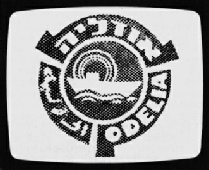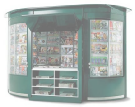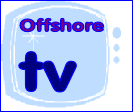© 2014-

Odelia TV
Press reports appeared in Israel on 6th April 1981 announcing that the MV Odelia, a Liberian registered ship flying the Honduran flag, had arrived off Ashdod the previous afternoon from Greece. At first she had been refused permission to enter port on suspicion that it was a floating television station, but when the Odelia did enter Ashdod she was immediately inspected by the authorities. Their suspicions, based on information passed to them by the Israeli ambassador in Athens, were confirmed when they discovered the transmitting equipment in the hold.
There was no reason for the authorities to detain the Odelia at that time but the crew were warned of penalties they faced for broadcasting without a licence inside Israeli territorial waters. After a few days the Odelia left Ashdod and anchored in a position off Tel Aviv, near the MV Peace, home of the Voice of Peace offshore radio station.
A Tel Aviv solicitor, Yosef Seger, acting on behalf of the Odelia's owners indicated that his clients had invested $2million in the project and that the ship would be used to broadcast Hebrew-
Speculation continued about who was really behind the offshore television project and what its true purpose was. This was fuelled by a story in an Athens newspaper, Kathimerini, that the publisher of a left-
It subsequently transpired that the original story in Kathimierini was incorrect and George Kouris was not involved with the Odelia ship or television project. Nevertheless the propaganda potential remained a cause of concern to many people, especially the Israeli authorities who made their position clear from the start. Israeli Finance and Communications Minister, Yoram Aridor, announced on 7th April 1981 that the Government would "employ all means at its disposal to disrupt television broadcasts from the ship, including jamming, and, if necessary, introduce legislation against broadcasts from beyond Israel's territorial waters."
This latter proposal would have also meant the Voice of Peace being outlawed and put an end to its 'accommodation' arrangement with the authorities, a factor which had deterred Abie Nathan in launching his own Voice of Peace TV station on two previous occasions.
The person actually behind the Odelia was Paul Greenwald, a Rumanian national who had lived in Israel for sixteen years, working with his father in the textile industry. He had been involved in a number of official enquiries into fraudulent activities and although never convicted Greenwald had also appeared before a number of Courts Martial for alleged desertion from the Israeli Army.
Since 1976 Pa ul Greenwald had nurtured the idea of starting an offshore television station, encouraged by the success of Abie Nathan's Voice of Peace radio station. He spent a long time trying to raise financial backing, find the right technical equipment and personnel and a suitable ship to act as a base for his planned station.
ul Greenwald had nurtured the idea of starting an offshore television station, encouraged by the success of Abie Nathan's Voice of Peace radio station. He spent a long time trying to raise financial backing, find the right technical equipment and personnel and a suitable ship to act as a base for his planned station.
In 1979 he placed an advertisement in an Israel newspaper for "staff to work for a private television station which broadcasts in colour." Although he claimed to have received several hundred replies no staff were actually recruited at that time.
It was not until 1980 that Paul Greenwald succeeded in finding a financial backer for his offshore television project and spent some time in Greece looking for a suitable vessel. Whilst in Greece he met shipowner, Nestar Pierrakios and told him of his plans. Pierrakios agreed to invest in the offshore television project and provide a ship which could be used as a floating base. He was quoted as saying:-
“When Greenwald came to Piraus and told me of his idea, I found it excellent. I am a ship-
I'm agreeing to an investment in a good subject, and making the attempt to discover a market which is new and free. I live in Athens, and it's all the same to me where the ship broadcasts. I don't believe that this is a pirate ship. A pirate is someone who takes something that does not belong to him, whereas with us everything is legal. Even if the venture doesn't succeed, I won't look on it as a loss. We are looking for new markets, and I believe in free initiative, so long as it is within the bounds of the law.”



Click on picture to enlarge
Photo: Offshore Echos Magazine/Radio News




Floor 2
Back to








